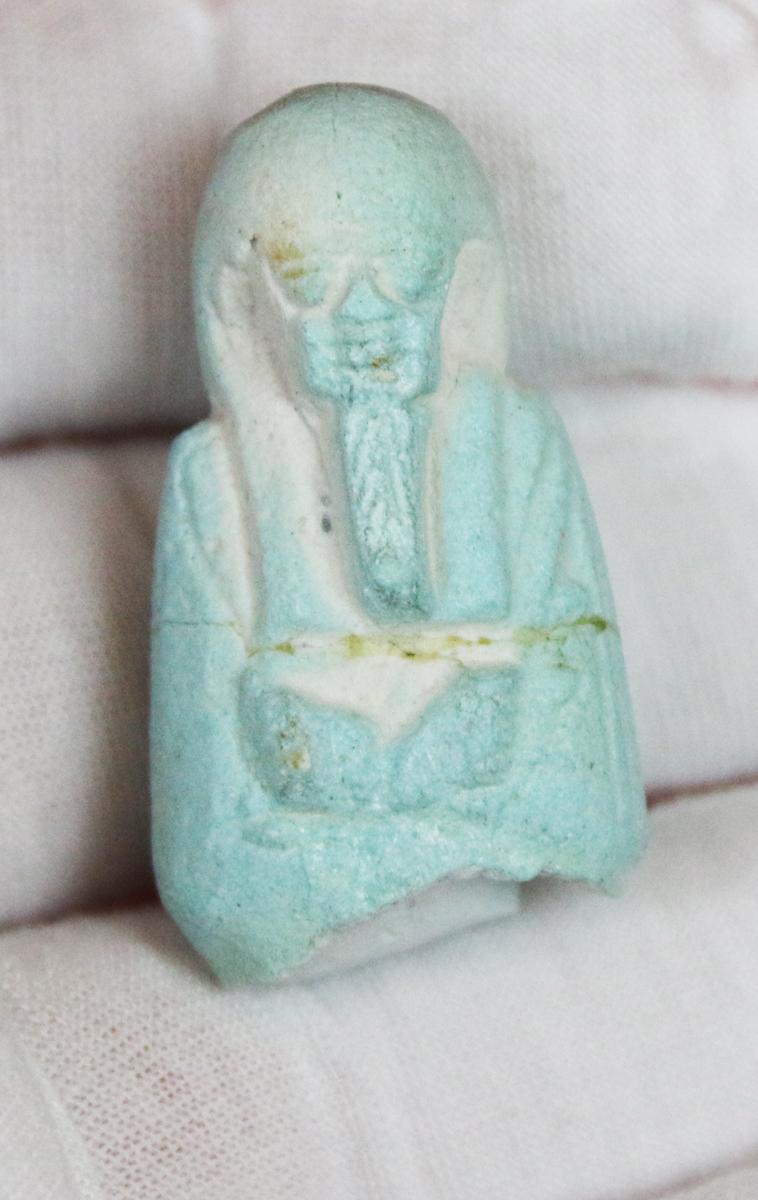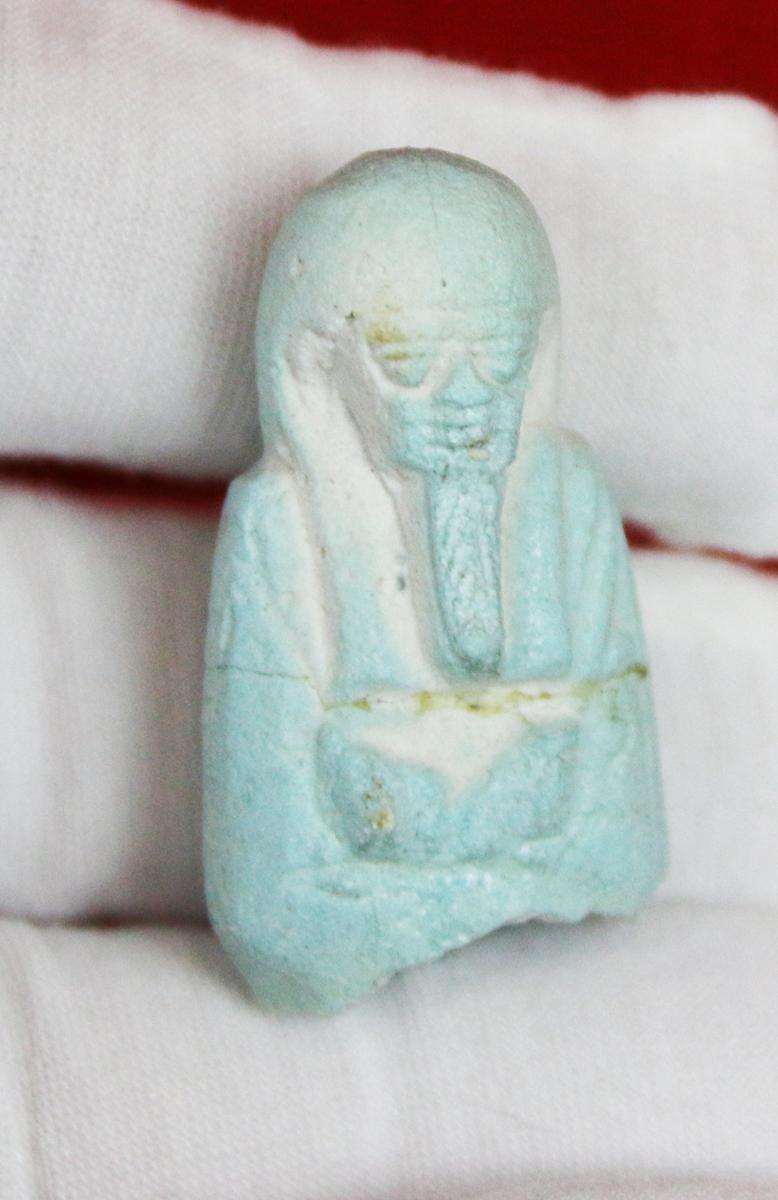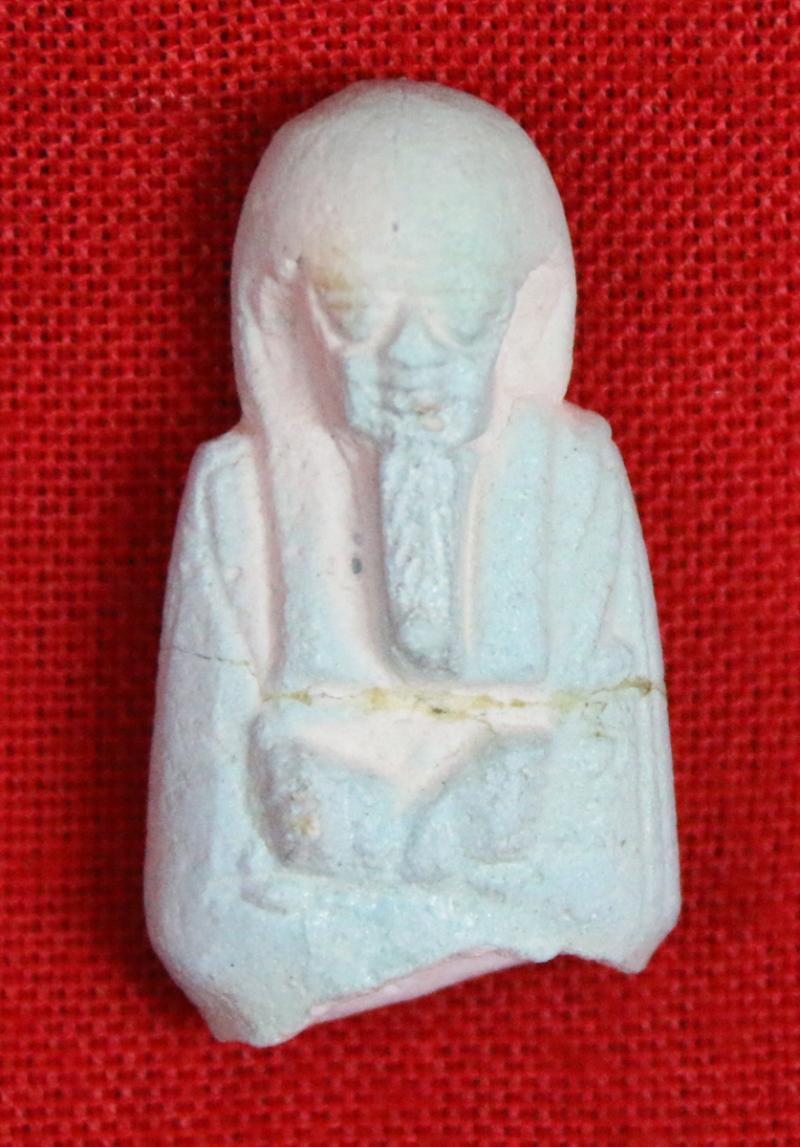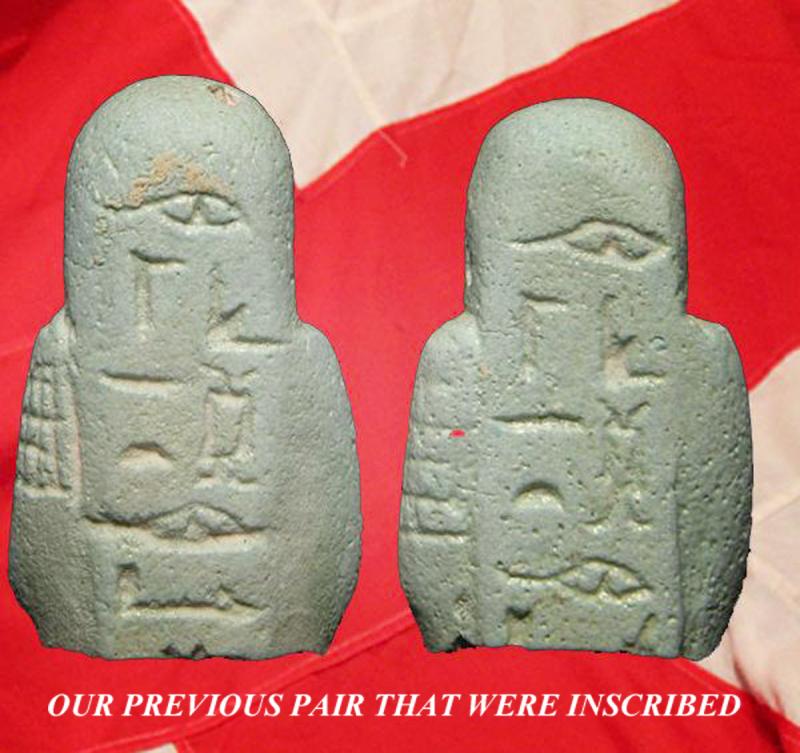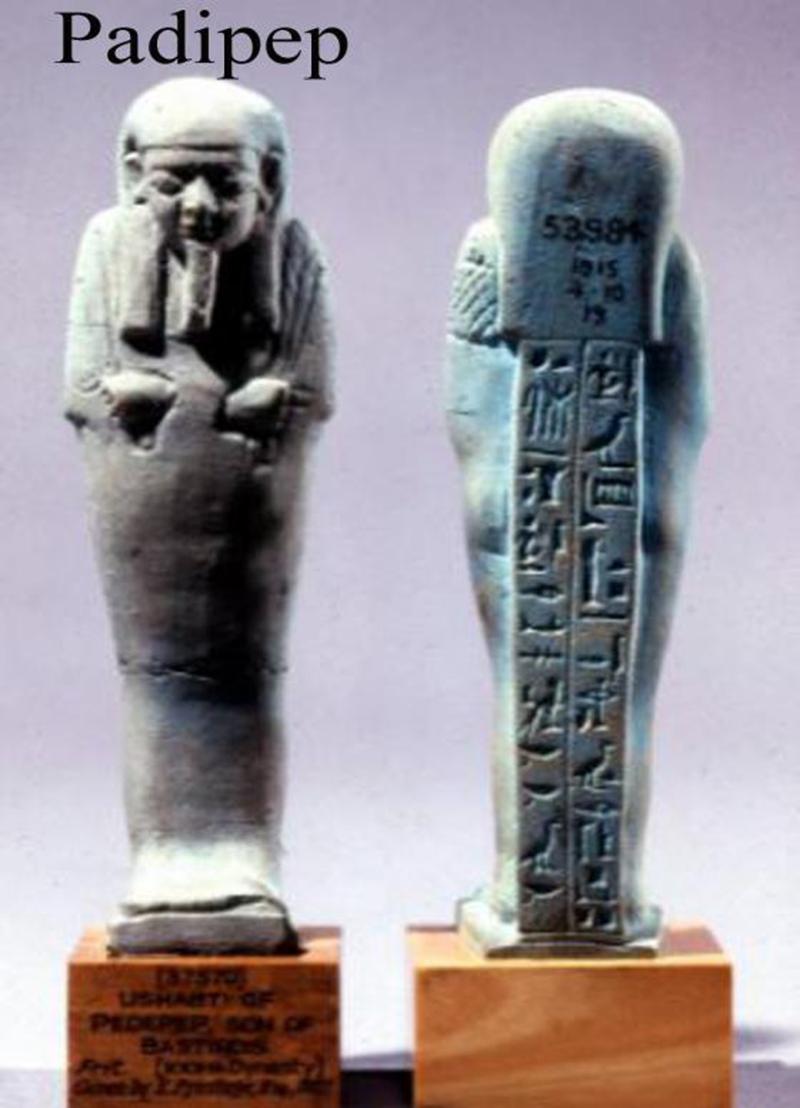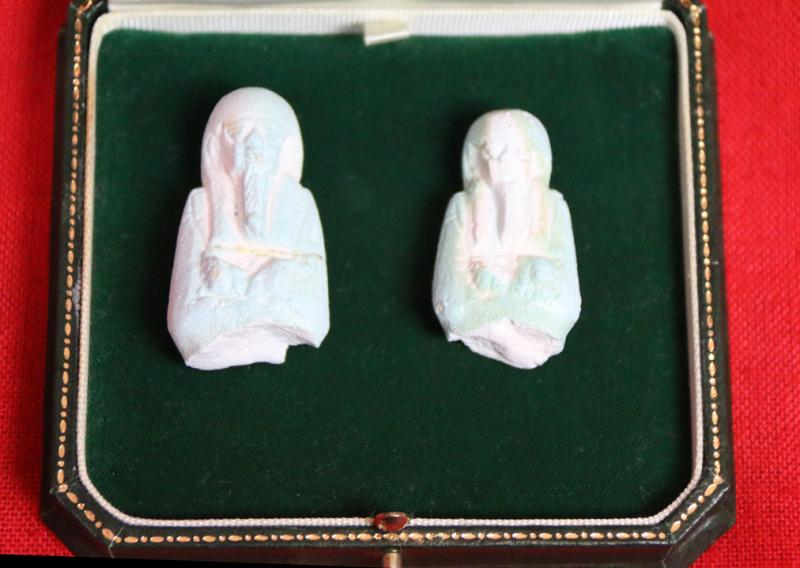A Finely Detailed Original Ancient Egyptian Shabti a Representation of a Mummified Human Tomb Figure, The Afterlife Servant of the Mummy, in Faience Blue Glazed Late Period, Dynasty XXVI, 664-525 B. C. From the Tomb of the Female Owner Bastet-ir-dis
Around 2500 years old. One of two we acquired, excavated from a tomb, and part of a collection formed before the 1970's. A light blue and green composition shabti comprising the remaining upper body, head and shoulders with crossed arms holding crook and flail, wearing a tripartite wig and false beard, semi-naturalistic detailing to the faces. A shabti (also known as shawabti or ushabti) is a generally mummiform small figurine found in many ancient Egyptian tombs. They are commonly made of blue or green glazed Egyptian faience, but can also consist of stone, wood, clay, metal, and glass.
We had two previously from the same collector that bore an inscription {these latest pair are not inscribed, but came from the same tomb} that included the name of the female owner Bastet-ir-dis (which can be translated as 'it was Bastet who gave it' i.e. the lady was the gift of the goddess Bastet), highlights the popularity of this feline deity during the Late Period and Ptolemaic/Roman times. Bastet was a protector of the sun god Re as well as being associated with motherhood and fertility. Bastet-ir-dis's name is preceded by 'the Osiris', a common appellation in shabti inscriptions of this and earlier periods, which associates the deceased with the preeminent ancient Egyptian god of the Underworld. The name was followed by the epithet 'true of voice' or 'justified', an attestation of the deceased's good character as judged by a divine tribunal that decided whether a person could enter the eternal Hereafter. Then follows the phrase 'born to' which would have been accompanied by the name of Bastet-ir-dis's mother on the now missing portion of these figures.
We show two other shabti found in other tombs of the children of Bastet-ir-dis, plus amazingly the actual sarcophagus of Bastit-ir-dis sold at Christies over 20 years ago, in 2001, for $30,550. Original Egyptian Sarcophagus have increased in desirability in the past 20 odd years exponentially, with some fetching as high as $1,000,000 {likely due because it is now forbidden to remove all antiquities from Egypt}
National Museum of Liverpool Shabti of Psamtek born of Bastet-ir-dis
664 BC - 525 BC (Dynasty 26)
British Museum number
Shabti of Padipep
Named in inscription: Bastet-ir-dis (born of)
An Ancient Egyptian painted Wood Anthropoid Sarcophagus of Bastet-ir-dis
Late Period, Dynasty XXVI, 664-525 B. C.
Gessoed and painted depicting the deceased, the lady Bastet-irdis, wearing a striated vulture cap covered wig, and a falcon terminated broad collar, the entire surface of the lid with mythological vignettes, funerary deities and their accompanying inscriptions, the principle among which are a kneeling, winged Isis, and the deceased on a bier; the join of the lid to the box decorated with an undulating serpent, the box with two long funerary offering formulae for the benefit of Bastet-irdis, the back with a profile figure of the "Goddess of the West" Sold originally in the Antiquitie sale, Sotheby's London, 8 December 1994, lot 100
The inscription includes the name of the female owner Bastet-ir-dis (which can be translated as 'it was Bastet who gave it' i.e. the lady was the gift of the goddess Bastet), highlights the popularity of this feline deity during the Late Period and Ptolemaic/Roman times. Bastet was a protector of the sun god Re as well as being associated with motherhood and fertility. Bastet-ir-dis's name is preceded by 'the Osiris', a common appellation in shabti inscriptions of this and earlier periods, which associates the deceased with the preeminent ancient Egyptian god of the Underworld. The name is followed by the epithet 'true of voice' or 'justified', an attestation of the deceased's good character as judged by a divine tribunal that decided whether a person could enter the eternal Hereafter. Then follows the phrase 'born to' which would have been accompanied by the name of Bastet-ir-dis's mother on the now missing portion of these figures.
The meaning of the Egyptian term is still debated, however one possible translation is ‘answerer’, as they were believed to answer their master’s call to work in the afterlife. Since the Fourth Dynasty (2613–2494 BC), for instance, the deceased were buried with servant statuettes like bakers and butchers, providing their owners with eternal sustenance. after the death of Cleopatra in around 37 b.c. and the close of the Ptolomeic Dynasty, no shabti were produced for service in Egyptian mummy's tombs. A spell was oft written on the shabti so that it would awaken as planned, this is the 'shabti spell' from chapter six of the Book of the Dead and reads as follows:
"O shawabti, if name of deceased is called upon,
If he is appointed to do any work which is done on the necropolis,
Even as the man is bounden, namely to cultivate the fields,
To flood the river-banks or to carry the sand of the East to the West,
And back again, then 'Here am I!' you shall say"1
2,000 to 2300 years old. From the Last pharoes of Egypt, that lasted for 275 years, up to the era of Julius Caeser, Cleopatra and Mark Anthony. With The last pharoah almost being the son of Julius Caeser, Caesarian but his mother famously committed suicide, and with the death of Cleopatra, thus the pharoic dynasties ended. Egyptian Blue Glazed Faience Ptolemaic dynasty sometimes referred to as the Lagid dynasty after Ptolemy I's father, who was a Macedonian Greek
The royal dynasty which ruled the Ptolemaic Kingdom in Ancient Egypt during the Hellenistic period. Their rule lasted for 275 years, from 305 to 30 BC. The Ptolemaic was the last dynasty of ancient Egypt.
Ptolemy, one of the seven somatophylakes (bodyguard companions), a general and possible half-brother of Alexander the Great was appointed satrap of Egypt after Alexander's death in 323 BC. In 305 BC, he declared himself Pharaoh Ptolemy I, later known as Sōter "Saviour". The Egyptians soon accepted the Ptolemies as the successors to the pharaohs of independent Egypt. Ptolemy's family ruled Egypt until the Roman conquest of 30 BC.
Like the earlier dynasties of ancient Egypt, the Ptolemaic dynasty practised inbreeding including sibling marriage, but this did not start in earnest until nearly a century into the dynasty's history. All the male rulers of the dynasty took the name Ptolemy, while queens regnant were all called Cleopatra, Arsinoe or Berenice. The most famous member of the line was the last queen, Cleopatra VII, known for her role in the Roman political battles between Julius Caesar and Pompey, and later between Octavian and Mark Antony. Her apparent suicide at the conquest by Rome marked the end of Ptolemaic rule in Egypt.
Richard Lassels, an expatriate Roman Catholic priest, first used the phrase “Grand Tour” in his 1670 book Voyage to Italy, published posthumously in Paris in 1670. In its introduction, Lassels listed four areas in which travel furnished "an accomplished, consummate traveler" with opportunities to experience first hand the intellectual, the social, the ethical, and the political life of the Continent.
The English gentry of the 17th century believed that what a person knew came from the physical stimuli to which he or she has been exposed. Thus, being on-site and seeing famous works of art and history was an all important part of the Grand Tour. So most Grand Tourists spent the majority of their time visiting museums and historic sites.
Once young men began embarking on these journeys, additional guidebooks and tour guides began to appear to meet the needs of the 20-something male and female travelers and their tutors traveling a standard European itinerary. They carried letters of reference and introduction with them as they departed from southern England, enabling them to access money and invitations along the way.
With nearly unlimited funds, aristocratic connections and months or years to roam, these wealthy young tourists commissioned paintings, perfected their language skills and mingled with the upper crust of the Continent.
The wealthy believed the primary value of the Grand Tour lay in the exposure both to classical antiquity and the Renaissance, and to the aristocratic and fashionably polite society of the European continent. In addition, it provided the only opportunity to view specific works of art, and possibly the only chance to hear certain music. A Grand Tour could last from several months to several years. The youthful Grand Tourists usually traveled in the company of a Cicerone, a knowledgeable guide or tutor.
The ‘Grand Tour’ era of classical acquisitions from history existed up to around the 1850’s, and extended around the whole of Europe, Egypt, the Ottoman Empire, and the Holy Land.
1.3/4"). Fair condition very old repair to mid section.
Code: 25667
395.00 GBP

